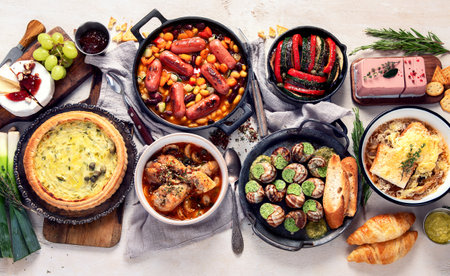1. Understanding Group Dynamics on the Trail
When backpacking across the diverse landscapes of the United States, mastering group dynamics is as essential as packing a reliable tent. Cooking and meal sharing in the backcountry aren’t just about food—they’re about teamwork. Effective communication is the backbone of any successful trail group. Everyone needs to be clear about dietary restrictions, cooking preferences, and daily schedules before hitting the trail. This keeps misunderstandings at bay and ensures everyone’s needs are met.
Leadership: Who’s Calling the Shots?
In every group, someone has to take point—whether it’s assigning cooking duties or making quick decisions when plans go sideways. Good leaders on the trail don’t bark orders; they listen, delegate based on strengths, and adapt quickly if someone’s energy crashes after a tough hike. Rotating leadership roles can keep things fair and prevent burnout.
Flexibility: Expect the Unexpected
No matter how dialed your plan is, the wild throws curveballs—bad weather, gear failure, or a surprise appetite spike after a brutal climb. Flexibility is non-negotiable. Groups that adapt—swapping meal nights, adjusting portions, or improvising with limited supplies—are the ones that thrive instead of merely surviving.
Building Trust Through Shared Responsibility
At its core, group cooking on the trail is about trust. When everyone pulls their weight—hauling ingredients, chopping veggies, or cleaning up—it builds camaraderie and respect. These foundations make every campfire meal not just filling, but memorable.
Meal Planning and Dietary Considerations
When it comes to group cooking on the trail, strategic meal planning is the backbone of a successful backpacking trip. American backpackers come from diverse backgrounds and often bring a variety of dietary preferences and restrictions to the table—literally. To keep everyone fueled and happy, you need to plan menus that are not only calorie-dense and packable but also inclusive of allergies, vegetarian or vegan lifestyles, gluten sensitivities, and religious dietary laws.
Surveying Group Needs
Start by surveying your group before the trip. Collect information on food allergies (nuts, dairy, soy), dietary restrictions (vegetarian, vegan, gluten-free), and personal preferences. Use a simple spreadsheet or group chat poll to gather this intel. This proactive approach prevents mishaps on the trail and ensures everyone can eat safely.
Inclusive Menu Strategies
Build your menu around base ingredients that are versatile and adaptable. For example, rice, quinoa, oats, beans, and pasta (gluten-free if needed) can serve as foundations for a wide range of meals. Then layer in toppings or sides that can be added or skipped depending on individual needs. Below is a practical way to structure your meal planning:
| Meal Component | Omnivore Option | Vegetarian/Vegan Option | Gluten-Free Option |
|---|---|---|---|
| Main Grain | Regular pasta or rice | Quinoa, brown rice | GF pasta or rice |
| Protein Add-on | Canned chicken/tuna, jerky | Lentils, beans, tofu | Lentils, beans, GF tofu |
| Sauce/Base Flavor | Pesto with cheese/meat | Tomato sauce with veggies | Oil-based herb dressing |
| Toppings/Extras | Nuts (if no allergy), cheese | Dried fruit, seeds, vegan cheese | Dried fruit, seeds (no wheat) |
Labeling and Cross-Contamination Prevention
If you’re prepping food ahead of time or repackaging in camp, label everything clearly. Use separate utensils and cookware for allergen-containing foods. In America’s outdoor community, cross-contamination is taken seriously—especially in groups with nut or gluten allergies. Assign specific tasks to group members who are trained in safe food handling procedures.
Trail-Tested Tips for Group Cooking Success
- Pack extra calories for those with high energy needs; don’t assume everyone eats the same amount.
- If possible, cook “bar-style” meals where each hiker builds their own bowl with available toppings.
- Bring spice packets or hot sauce so each person can customize flavor without compromising the base meal’s safety.
- Plan a shared treat that everyone can enjoy—think allergen-free cookies or fruit crisps cooked in a pan over the fire.
- Always have backup snacks that meet all dietary restrictions in case someone’s primary meal doesn’t work out.
The Bottom Line
A little pre-trip communication and thoughtful packing go a long way. By building flexibility into your group cooking strategy and being mindful of American dietary norms—from gluten-free to plant-based—you’ll keep spirits high and stomachs satisfied out on the trail.
![]()
3. Gear Selection and Division of Labor
Efficient group cooking on the trail starts with smart gear choices and clear division of labor. For backpackers in the US, weight, durability, and versatility are key factors when selecting communal cooking equipment. The classic MSR WhisperLite stove remains a favorite for its reliability and ability to handle big pots, while lightweight Jetboil systems excel for fast water boiling. Don’t forget a sturdy bear canister or Ursack—essential for US backcountry food storage regulations.
Choosing the Right Gear
One-pot meals are the gold standard among American backpackers because they cut down on cleanup and fuel use. Opt for a large titanium or hard-anodized aluminum pot that can serve everyone at once. Pair it with a compact cutting board, a sharp multi-tool or camp knife, and a collapsible sink for washing up. A long-handled spoon, spatula, and lightweight bowls round out the essentials. Assign one person to carry the main cook kit; others can split up fuel canisters, utensils, or shared spices to balance the load.
Division of Labor: Who Does What?
Clear roles prevent chaos come dinner time. Rotate responsibilities daily or by meal: one person handles water gathering and filtration, another preps ingredients, someone else cooks, and another cleans up. In larger groups, assign a “quartermaster” to track gear and food inventory. This system not only boosts efficiency but also builds trust and camaraderie—no one wants to be stuck with dishes every night.
Trail-Tested Tips
Veteran US backpackers swear by checklists to prevent forgotten items or duplicate gear. Always hold a quick gear shakedown before heading out. If you’re hiking in bear country (like the Sierra Nevada or Rockies), designate one member as the “bear hang captain” to manage nightly food storage protocols. Ultimately, success comes down to teamwork—when everyone knows their job and shares the load, group meals become a highlight of any backcountry adventure.
4. Trail-Tested Cooking Techniques
Backcountry cooking in the US demands rugged, efficient, and safe methods that can stand up to unpredictable weather and tough terrain. Whether you’re tackling the Rockies or hiking through the Appalachian backwoods, your group’s meal plan needs to be foolproof. Here’s how seasoned backpackers handle mealtime in the wild:
Efficient Heat Sources
Choosing the right stove is a game-changer. Canister stoves like Jetboil or MSR PocketRocket are ultralight and fast-boiling—perfect for groups needing hot food quickly. Liquid fuel stoves (such as MSR WhisperLite) excel in cold temps or at altitude. Always set up on stable ground and shield flames from wind with rocks or purpose-built wind screens.
| Stove Type | Best For | Pros | Cons |
|---|---|---|---|
| Canister Stove | Quick meals, small groups | Fast, easy to use | Fuel canisters can be hard to find in remote areas |
| Liquid Fuel Stove | Larger groups, cold weather | Works at altitude/cold, refillable | Heavier, more maintenance required |
| Alcohol Stove | Ultralight solo trips | Lightweight, cheap fuel | Slow boil, less efficient for big groups |
| Wood-Burning Stove/Fire Pit* | Sheltered campsites (where legal) | No need to carry fuel | Banned during fire season, uneven heat control |
*Always check local regulations before starting any fire.
No-Fuss Cooking Methods for Groups
- One-Pot Meals: Minimize cleanup by prepping all-in-one dishes like chili, stews, or pasta. Assign one person as “camp chef” per meal to streamline tasks.
- Bake-in-a-Bag: Use heavy-duty freezer bags for mixing and rehydrating meals—just add boiling water and seal. Bonus: no pot scrubbing.
- Foil Packets: Wrap proteins and veggies in foil, toss them over coals (where fires are allowed), and get a hot dinner with zero mess.
- Bannock Bread: Mix flour, baking powder, salt, and water into dough, then fry it in a pan or bake on a stick over your campfire.
- Cowboy Coffee: Boil water, throw in grounds, let them settle—classic trail brew with minimal gear.
Safety First: Group Cooking Protocols
- Bear Awareness: In bear country (think Yellowstone or Sierra Nevada), cook at least 200 feet from your sleeping area and store all food in approved bear canisters or hang bags.
- Douse Fires Completely: Use water—not dirt—to fully extinguish flames. Stir embers until they’re cool to the touch before leaving camp.
- Avoid Cross-Contamination: Designate one cutting board for raw meats/veggies and another for cooked foods; wash hands with biodegradable soap well away from water sources.
- Packing Out Waste: Leave No Trace isn’t just a motto—it’s law in most US parks. Pack out every scrap of trash and food waste.
Tactical Tips for Efficiency
- Buddies on Prep Duty: Assign roles so one person boils water while another chops veggies; streamline workflow to get hot chow fast after a long day on the trail.
- Nesting Cookware: Choose pots that fit inside each other and share utensils to save space and weight.
- Preset Meal Kits: Pre-measure spices and dry ingredients into labeled bags before hitting the trail—no need to haul full jars or containers.
- Keep It Simple: Stick with tried-and-true recipes that everyone knows how to make; field-testing new meals should wait until home base.
5. Portioning, Sharing, and Cleanup Protocols
When cooking and eating together on the trail, fair portioning and responsible cleanup are non-negotiable for American backpackers.
Equitable Meal Division
Start by agreeing on meal portions before you even light the stove. Use lightweight measuring cups or pre-marked containers to split food evenly—nobody wants an awkward food shortfall halfway through the hike. Assign a “meal master” for each cook session to oversee fair distribution, especially when resources run thin. Remember, group morale hinges on everyone feeling fed and respected.
Meal Sharing Etiquette
Backcountry meals are communal affairs. Rotate cooking responsibilities daily so nobody burns out or feels exploited. If allergies or dietary restrictions exist, plan ahead so everyone has something safe and satisfying to eat. In American outdoor culture, it’s common courtesy to offer seconds only after everyone’s had their share. Always ask before raiding shared snacks; what’s fair in town can cause friction in the wild.
Leave No Trace Cleanup Tactics
Minimize Impact
The Leave No Trace (LNT) ethos runs deep in the US backpacking scene. Scrape your cook pots clean with a spatula to reduce food waste before washing. Strain any leftover particles from dishwater using a mesh bag or bandana—pack out all solids.
Efficient Dish Duty
Divide cleanup tasks: one person scrapes, another washes, a third dries and stows gear. Use biodegradable soap sparingly at least 200 feet from water sources. Scatter strained graywater over a wide area; never dump it in streams or lakes.
Pack Out All Waste
No exceptions—every bit of trash, food packaging, and micro-waste goes back in your pack until you hit civilization. Double-bag particularly messy items to avoid leaks and odors. This isn’t just etiquette; it’s survival strategy for preserving America’s wild places for future hikers.
By sticking to these protocols, you’ll keep group dynamics strong, minimize environmental impact, and earn respect from seasoned American backpackers who live by the code: “Take only memories, leave only footprints.”
6. Conflict Resolution and Group Cohesion
Backpacking in the US isn’t just about surviving the wilderness—it’s about thriving as a team. When it comes to group cooking and meal sharing, even the best-laid plans can trigger friction. Food preferences, dietary restrictions, and uneven workloads are classic flashpoints. Here’s how seasoned American backpackers tackle disputes head-on and keep morale high.
Establish Ground Rules Early
Before you hit the trail, gather your group and lay down clear expectations for meal prep, cleanup, and ingredient contributions. Use direct, no-nonsense language: “Everyone cooks once before anyone cooks twice.” This hardline approach prevents freeloading and sets a fair tone from day one.
Designate a ‘Camp Cook’ Rotation
Create a rotating schedule for kitchen duty. Post it on your bear can or inside your communal tent. American backpackers appreciate structure—it minimizes confusion and excuses, giving everyone their time to shine (or burn the chili).
Tackle Issues Head-On—Don’t Let Them Simmer
If tension bubbles up over burnt pancakes or food hoarding, address it immediately around the campfire. Use “I” statements: “I feel frustrated when cleanup is skipped.” Keep things factual, not personal. Avoid passive-aggressive comments or letting issues fester overnight—open communication is key in American outdoor culture.
Embrace Flexibility and Humor
When plans change—maybe rain soaks your wood or someone forgets the mac-and-cheese—roll with it. Crack a joke, improvise a new dish, and remind each other that adaptability is a badge of honor among US backpackers.
Cement Group Morale with Shared Rituals
Wrap up every night with a quick team huddle: share highs, lows, and tomorrow’s menu plan. Celebrate small wins (that perfectly toasted s’more) and laugh off fails. In the backcountry, camaraderie is forged over meals—and battle-tested through conflict resolution.
By setting ground rules, tackling disputes head-on, staying flexible, and building rituals around food, American backpackers turn potential conflicts into opportunities for stronger group cohesion. Out here, teamwork isn’t optional—it’s survival.


